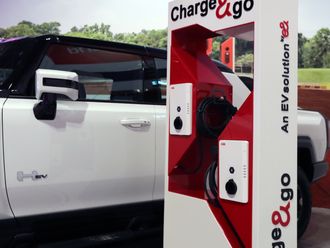In Kenya, man and machine unite to protect the black rhinoceros and its precious ecosystem.
Kenya's Rhino Charge took place at Ol Kinyie Ranch in the Narok area, 215 kms south of capital Nairobi, this summer.
The Charge is all about skilfully driving a reasonably powerful 4x4 vehicle through thick unyielding bush, down ravines, up boulder-strewn hillsides, to reach 13 guard posts in the shortest distance and within 10 daylight hours.
Plus approaching the Gauntlet with a positive "go-do" attitude and having fun.
The purpose of the Rhino Charge is to raise large amounts of money to erect an electrified multi-strand fence enclosing the Aberdare Forest.
The 320-kilometre fence will surround not only the largest indigenous forest in East Africa, but also the Aberdare National Park, where Britain's Queen Elizabeth II became Queen while staying at Tree Tops, the night her father, George VI, died in 1952.
The Rhino Ark is an organisation set up in 1988 by the late Ken Kuhle, who passed away just weeks before this year's Charge.
Ken, with a few other people, felt the need to curb the brutal killing of black rhino and in so doing, to also set objectives seeking solutions concerning the Aberdare mountain range and its ecosystem; to conserve the forest and its total habitat.
The residents in Nairobi and businesses as well as outlying towns depend mainly on the many rivers of the Aberdare and Mount Kenya mountain complex.
This year, 53,322,470 Kenya Shillings (Dh2,026,253) was raised for the 2005 event. Every year, each person involved is amazed at the amount donated when the total is read out.
This year was no exception; the money is enough to complete this year's scheduled erecting of Phase five's 75 kilometres.
Financing agreement
The European Union's Biodiversity Conservation Programme (BCP) has signed a financing agreement with Rhino Ark to support the Kekika Community Fence Project.
The Forest Department will also receive BCP support to purchase materials. Carbacid, a company that makes carbon dioxide gas nearby, has responded with a pledge of money.
Every bit helps, particularly as the toughest ground — almost twice as long as any of the other phases — has yet to be completed. Phase 6, on the south-western side, is 25 kilometres.
Work is predicted to start during the second quarter of 2005, a first case of two construction teams working at the same time.
The total build target for this year is 55 kilometres.
Maintaining the fence is essential and will need to continue for life. The Rhino Ark policy is that 20 per cent of the funds raised goes to fence maintenance, while 80 per cent goes to fence construction.
Other means of raising revenue include the sale of raffle tickets, which brings in more than a million shillings for the area projects, with various companies donating generous prizes. There were 124 prizes in all this year.
The top prize was a 4x4 Maruti. KLM, Kenya Airways and Ethiopian Airlines all donated air tickets.
Camping fees are charged for each vehicle entering the ranch as a landowner's access fee.
The money raised will go towards fulfilling workable projects for the community on whose land the Charge took place.
They include building much needed dormitories at the co-education school and constructing a road entering the ranch and making their borehole usable. Rhino Ark officials will monitor these projects.
Entrance easy
Anyone of reasonably sound mind, from teenagers up to almost geriatric age, may enter this incredibly challenging event for an entrance fee.
The "no road rally" is now so popular participants are putting money where their mouths are, including overseas "must-do" competitors, to win the honour of the Duncan Mitchell Perpetual Trophy.
Fifty local machines are accepted for each Charge, with 5 more from overseas, meaning 350 men, women and youngsters take part in an experience not to be forgotten.
With only 6 to a vehicle, 3 or 4 runners scout ahead and decide the best and shortest route for their vehicle.
Each entrant is given a map of the area and the grid references of the various guard posts at a driver's briefing the evening before the event, which starts very early in the morning. GPS's are used to aid navigators.
Six young men had brains, brawn and willpower to win.
Will and Mikey Carr-Hartley, Neil McRae, Simon Evans, David Francombe and Justin Larby drove their Range Rover No 42, checking into all 13 guard posts, including the Gauntlet's 3 posts, and returned to their original starting post in 57.8 kilometres.









